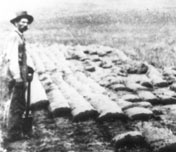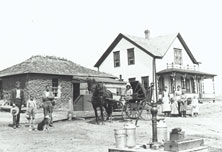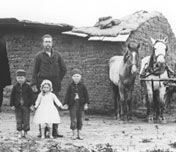Historic time period: 1801–1861
More Information

Homesteader cutting sod in South Dakota.
Copyright © 2002 Smithsonian National Museum of American History | Courtesy of the Nebraska State Historical Society.
View largerFree Land
In 1862 the U.S. Congress passed the Homestead Act. This law permitted any 21-year-old citizen or immigrant with the intention of becoming a citizen to lay claim to 160 acres of land known as the Great American Prairie. After paying a filing fee, farming the land, and living on it for five years, the ownership of the land passed to the homesteader.
People came from all over the world to take advantage of this opportunity. By 1900 over 600,000 claims had been filed.
Life on the Prairie
The homesteaders faced many challenges. Everything about the prairie was extreme. The land was flat and treeless and the sky seemed to go on forever. On a tall-grass prairie, the grass sometimes grew to be more than 6 feet tall. It is said that riders on horseback could pick wildflowers without dismounting. Women worried about their children getting hopelessly lost in the grass.
Summer brought endless days of heat when the surface temperature could exceed 120 degrees. Periods of drought, rainstorms, tornadoes, swarms of grasshoppers that could destroy fields of crops, and never-ending wind also challenged settlers.
Winters were long and cold. Blizzards were so strong that they could trap livestock and homesteaders under the snow. During the long winter of 1886, horses and cattle died when their breaths froze over the ends of their noses, making it impossible for them to breathe.
Building a home and establishing a farm was a challenge for even the most experienced farmers, but the free land, abundant wildlife, and richness of the soil made the challenge hard to resist.

Mr. and Mrs. Curry in front of their sod house.
Copyright © 2002 Smithsonian National Museum of American History | Courtesy of the Nebraska State Historical Society.
View largerChoosing Your Homestead
Choosing the right location for a homestead was very important. Newly arrived settlers, known as "sod busters," looked for land which featured a stream or creek and small rolling hills which served as windbreaks. Easy access to planned railroad lines was also an asset because it made it easier to ship goods and livestock to market. Once the land was selected, the homesteader went to the Land Office to make sure that the property was not already taken and to file a claim.
One of the requirements for fulfilling the claim was building a "home" to live in within six months. Choosing the right site for a house was nearly as important as choosing the right claim. Building next to a small hill provided some protection from the constant wind. Being near a stream meant easy access to water. But building too close also made flooding a very real danger.
Building a House
Without trees or stone to build with, homesteaders had to rely on the only available building material — prairie sod, jokingly called "Nebraska marble." Sod is the top layer of earth that includes grass, its roots, and the dirt clinging to the roots. Building a sod house was a lot of work and often took many weeks, especially if the settler's nearest neighbors were too far away or unable to help.
Because tents or the top of a covered wagon provided little comfort or shelter from the prairie's wild weather, many settlers began by building dugouts. Dugouts were small, dark spaces dug into the side of a hill that could be made quickly and were much warmer and drier than tents. Many people built a sod house right in front of the dugout and then used the dugout as another room.

A family posing beside their new frame house and their sod house.
Copyright © 2002 Smithsonian National Museum of American History | Courtesy of the Nebraska State Historical Society.
View largerCutting Sod
Cutting sod was a very difficult task. Motorized tractors weren't commonly available to farmers until the 1910s. Farmers in the 1800s used mules, oxen or horses, and special plows equipped with curved steel blades to cut through the tough roots of the sod. The roots were so tough that as the plow cut through the sod a loud tearing sound was created.
Farmers soon learned that they should only cut as much sod as they planned to use in one day. Sod quickly dried, cracked, and crumbled if not used immediately. Most farmers cut sod from the area where they planned to build their house. Doing so provided a flat surface on which to build and helped protect the house from prairie fires. Removing the grass from the area also helped keep insects, snakes, and vermin from burrowing into the house.
Building the House
Most homesteaders cut bricks that were 18 inches wide by 24 inches long and weighed around 50 pounds each. Approximately 3000 bricks were required to build a 16 x 20 foot house. Freshly cut sod bricks were laid root-side up in order for the roots to continue to grow into the brick above it. Over time, the bricks in fact grew together to form a very strong wall.
Today, most houses in the United States are built straight up and down, with angled roofs, and brick or wooden exterior walls that keep out the rain and other elements. Sod houses, however, required a thick, wide foundation. The walls sloped down on the outside of the house so that as the walls settled, they would not collapse. The top of the house looked smaller than the bottom.
Putting in Windows
Windows were the most expensive part of a sod house and were difficult to install. After setting the frame into the wall, the builder continued to lay rows of sod around it. When the bricks reached the top of the window frame settlers left off two layers of brick and laid cedar poles over the gap. The resulting space, stuffed with grass or rags, protected the windows from breaking as the house settled.

A sod house with a collapsed roof.
Copyright © 2002 Smithsonian National Museum of American History | Courtesy of the Nebraska State Historical Society.
View largerMaking a Roof
The roof was the most difficult and dangerous part of the house to build. The lack of normal roofing materials, like wooden shingles or slate tiles, led to the inventive use of natural materials. A series of cedar poles held up layers of brush tied into bundles, mud, grass and sod. These roofs were a constant source of irritation and concern. Dirt or water, depending on the weather, fell from the ceiling most of the time. People hung muslin sheets from the ceiling to keep dirt from dropping into their food or an occasional snake from falling on to their bed. Roofs that became too wet sometimes collapsed.
Moving In!
Many people were surprised by the coziness of dugouts and sod houses. They were cool in the summer, warm in the winter and good shelter from the wild prairie weather. The fact that they were basically made of dirt made them virtually fireproof.
Turning a Soddie into a Home
Most sod houses were about 16 feet by 20 feet and had only one room. Furniture was kept to a minimum due to the lack of space. Beds and tables were often built right into the walls. Many people slept on pallets that could be moved out of the way during the day. Crowded conditions meant that some household objects, like sewing machines, were kept outside when the weather was good, and had to be squeezed inside when it rained or snowed.
Smoothing the inside walls and either plastering or wallpapering them brightened the room and helped keep out mice. Women found floors made from packed dirt hard to live with. Adding raised wooden floors was usually one of the first improvements that homesteaders made to their sod houses.
Flowers on the wide windowsills and pets — dogs, cats, and caged birds — made the house feel like a home. Many settlers threw flower seeds up on the roofs that brightened up their dugouts when they bloomed.
The requirements for fulfilling the terms of the claim agreement varied for different types of claims. Whether it meant building a structure to live in within six months; raising successful crops and staying for five years; planting a certain number of acres of trees; or purchasing the land from the government — less than 50 percent of homesteaders succeeded.
Bad weather, illness, accident or loneliness could all bring a homesteader's dream of land ownership to a bitter end. Those who failed went "back home" or continued moving west.
For those who stayed, time and experience often led to more successful crops and eventually to moving out of the soddie and into a frame house. Most soddies became barns or storage buildings.



